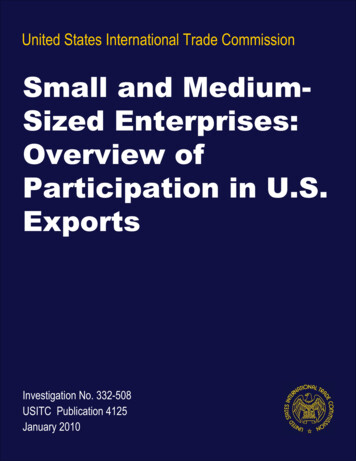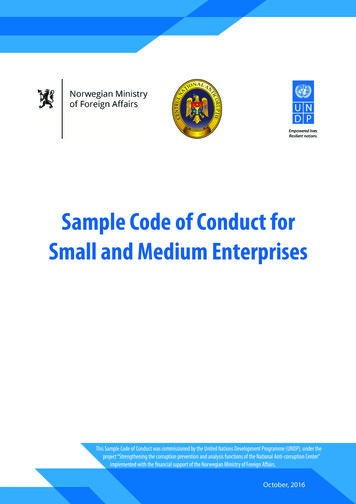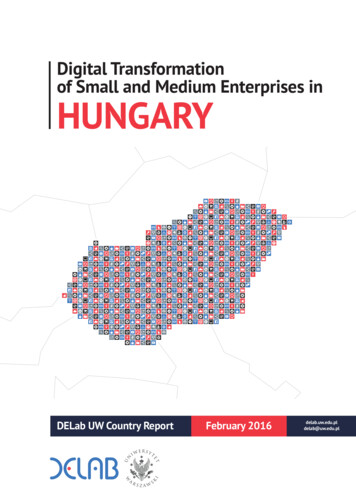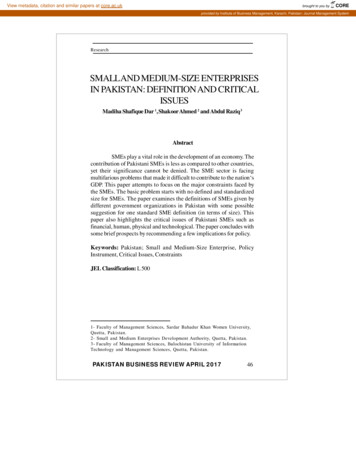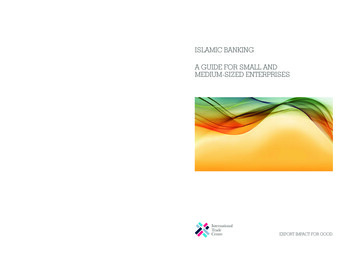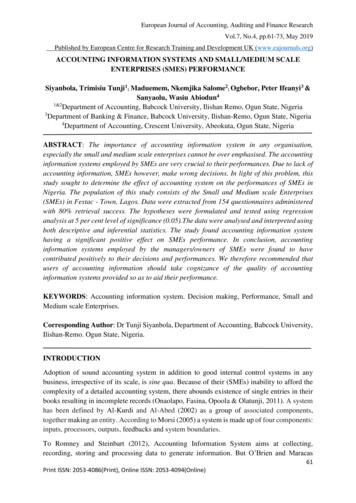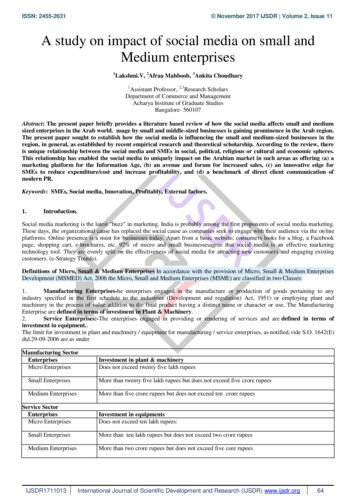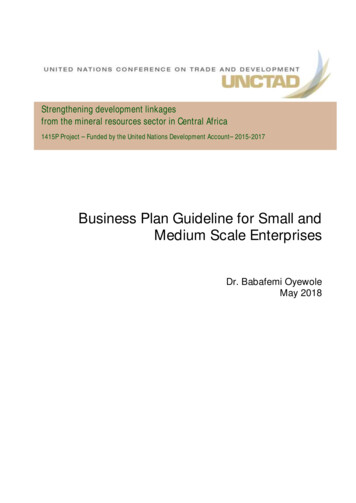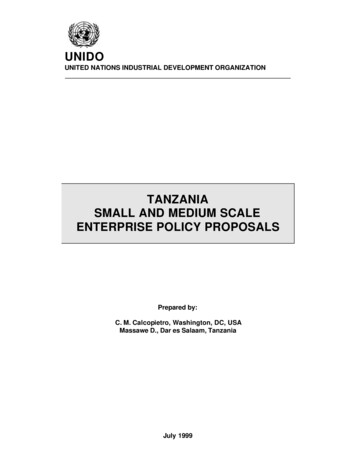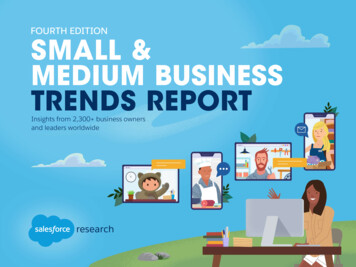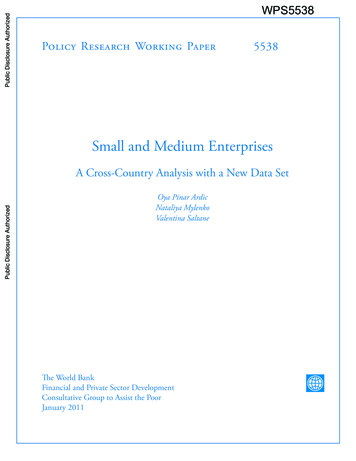
Transcription
Public Disclosure AuthorizedPublic Disclosure AuthorizedPublic Disclosure AuthorizedPublic Disclosure AuthorizedWPS5538Policy Research Working Paper5538Small and Medium EnterprisesA Cross-Country Analysis with a New Data SetOya Pinar ArdicNataliya MylenkoValentina SaltaneThe World BankFinancial and Private Sector DevelopmentConsultative Group to Assist the PoorJanuary 2011
Policy Research Working Paper 5538AbstractIn the aftermath of the global financial crisis of2008–2009, there has been an increased interest in therole of small and medium enterprises in job creationand economic growth. However the lack of consistentindicators at the country level restricts extensive crosscountry analyses of lending to small and mediumenterprises. This paper introduces a new dataset to fill thisgap in the small and medium enterprise data landscape.In addition, it provides the first set of results of analyseswith this new dataset, predicting the global small andmedium enterprise lending volume to be 10 trillion.The bulk of this volume, 70 percent, is in high-incomecountries. On average, small and medium enterpriseloans constitute 13 percent of gross domestic productin developed countries and 3 percent in developingcountries. Note that although a unique small andmedium enterprise definition does not exist, differencesin definitions across countries are not statisticallysignificant in explaining the differences in small andmedium enterprise lending volumes.This paper is a product of the Financial Access Team in Consultative Group to Assist the Poor, Financial and Private SectorDevelopment. It is part of a larger effort by the World Bank to provide open access to its research and make a contributionto development policy discussions around the world. Policy Research Working Papers are also posted on the Web at http://econ.worldbank.org. The author may be contacted at nmylenko@worldbank.org.The Policy Research Working Paper Series disseminates the findings of work in progress to encourage the exchange of ideas about developmentissues. An objective of the series is to get the findings out quickly, even if the presentations are less than fully polished. The papers carry thenames of the authors and should be cited accordingly. The findings, interpretations, and conclusions expressed in this paper are entirely thoseof the authors. They do not necessarily represent the views of the International Bank for Reconstruction and Development/World Bank andits affiliated organizations, or those of the Executive Directors of the World Bank or the governments they represent.Produced by the Research Support Team
Small and Medium Enterprises:A Cross-Country Analysis with a New Data Set*Oya Pinar ArdicNataliya MylenkoValentina SaltaneKeywords: Small and Medium Enterprises (SMEs); Financial access; Credit constraints;RegulationJEL Classification: G21, G28, O16*The World Bank / CGAP. We are grateful to Maximilien Heimann, Joyce Antone Ibrahim, and Kristine Cronin forresearch assistance. This paper’s findings, interpretations, and conclusions are entirely those of the authors and donot necessarily represent the views of CGAP, CGAP’s Council of Governors or Executive Committee, the WorldBank, its Board of Executive Directors, or the countries they represent. Data available at:http://www.cgap.org/financialindicators
1.IntroductionRecent studies show that SME development is closely linked with growth. For example, Beck etal. (2005a) find a robust, positive relationship between the relative size of the SME sector andeconomic growth, even when controlling for other growth determinants. According to Ayyagariet al. (2007), in high-income countries formal SMEs contribute to 50 percent of GDP on average.Furthermore, in many economies the majority of jobs are provided by SMEs. In OECDcountries, for example, SMEs with less than 250 employees employ two-thirds of the formalwork force (Beck et al., 2008b; Dietrich, 2010). Using country-level data, Ayyagari et al.estimate that, on average, SMEs account for close to 60 percent of employment in themanufacturing sector. According to SME Performance Review (EC, 2009), between 2002 and2008, the number of jobs in SMEs increased at an average annual rate of 1.9 percent while thenumber of jobs in large enterprises increased by only 0.8 percent. In absolute numbers, 9.4million jobs were created in the SME sector in EU-27 between 2002 and 2008. Also, it is oftenargued that SMEs are more innovative than larger firms. In developed countries, SMEscommonly follow “niche strategies,” using high product quality, flexibility, and responsivenessto customer needs as a means of competing with large-scale mass producers (see, for example,Hallberg, 2000, and Snodgrass and Biggs, 1996).As the world economies are recovering from the financial crisis of 2008-9, many economiesurgently need to create employment opportunities for their citizens. In this respect, creation andgrowth of SMEs is an important item on the policy agenda due to evidence that points tosignificant contributions by SMEs to employment. In addition, regulatory measures arenecessary to ease access to formal financial services by SMEs. Historically, SMEs have beenmore likely than larger firms to be denied new loans during a financial crisis. For example,Hallberg (2000) argues that the events of the 1990s in Latin America and East Asia confirm thisproposition. More recently, in the aftermath of the global financial crisis, SME PerformanceReview (EC, 2009) reports anecdotal evidence pointing to insufficient market demand as theprime obstacle faced by SMEs, followed by difficulties in accessing finance.Given the importance of SMEs in supporting sustainable, diversified, long-term economicgrowth, they have, indeed, attracted renewed attention in the wake of the 2008-9 financial crisis.2
Recently, at the Pittsburgh G-20 summit, the G-20 has committed to identifying lessons learnedfrom the innovative approaches to the provision of financial services to SMEs and to promotingsuccessful regulatory and policy approaches.1 SME development is high on the reform agenda ofmany governments. A broad range of policies and programs target improvements in SMEbusiness environments, as well as financial support to SMEs.Despite the importance of SMEs for job creation and production, most of the SME literaturepoints to the fact that small and medium firms face higher barriers to external financing thanlarge firms, which limits their growth and development.2 Numerous studies that use firm-levelsurvey data demonstrate that access to finance and the cost of credit do not only pose barriers toSME financing, but also constrain SMEs more than large firms. Small firms find it difficult toobtain commercial bank financing, especially long-term loans, for a number of reasons,including lack of collateral, difficulties in proving creditworthiness, small cash flows, inadequatecredit history, high risk premiums, underdeveloped bank-borrower relationships and hightransaction costs (IFC, 2009). This is evidenced in the works of Scholtens (1999), Schiffer andWeder (2001), Galindo and Schiantarelli (2003), IADB (2004), Beck et al. (2006), and Beck andDemirgüç-Kunt (2006).3 In particular, Beck et al. (2008a) conclude that smaller firms and firmsin countries with underdeveloped financial and legal systems use less external finance, based ondata from a firm-level survey in 48 countries.4A broad range of business environment factors are linked to SME performance. For example,Ayyagari et al. (2007) find that lower costs of entry and better credit information sharing areassociated with a larger size of the SME sector, while higher exit costs are associated with alarger informal economy. The overall banking structure is another important factor. Shen et al.1See the Pittsburgh G-20 Summit “Leaders’ Statement” at http://www.pittsburghsummit.gov.Enterprise Analysis survey data at http://www.enterprisesurveys.org/; IFC (2009); Beck et al (2008b).3For earlier research, see Hartwell (1947) who reports a negative correlation between loan size and interest rates,and Murphy (1983) who argues that small loans to small firms are more costly for the lenders.4Studies that focus on a specific country report similar results. Stephanou and Rodriguez (2008) find that access tocredit is one of the biggest constraints for SMEs in Colombia; Binks and Ennew (1997) find that the mainconstraints to growth of SMEs in the UK include management, labor skills, regulation and lack of access to finance;Hutchinson (2006) compares the cases of a leading transition country, Slovenia and an established market economy,Belgium, and finds that the SME sector in Slovenia remains underdeveloped, mainly due to the inability to raiseexternal finance. Studies by Anderson and Kegels (1997), Budina et al. (2000), Gros and Suhrcke (2000), Koningset al. (2003) all indicate that this appears to be the case in most of Central and Eastern Europe.23
(2009), using Chinese data, find that total bank assets are not significant for banks’ decision tolend to SMEs. Yet, more local lending authority, more competition, carefully designed incentiveschemes, and stronger law enforcement encourage commercial banks to lend to SMEs.Macroeconomic instability in developing countries and competition in developed countries areperceived as the biggest obstacles to SME finance. Rocha et al. (2010) provide supportiveevidence from banks in Middle East and North Africa, noting lack of SME transparency andunderdeveloped financial systems as the main obstacles.5,6 At the same time, a recent study byBeck et al. (2008b) indicates that most commercial banks perceive the SME sector as profitable.The lack of consistent indicators restricts extensive cross-country analyses of SME lending. Mostcountries either do not collect data on SME lending or do so on an ad hoc basis. Even when SMEdata are available, it is extremely difficult to perform a cross-country analysis in the absence of astandard definition as to what constitutes an SME. Though SMEs are commonly defined asregistered businesses with less than 250 employees (IFC, 2009), the definition still varies fromcountry to country and even from bank to bank. In this respect, an OECD conference on SMEs in2004 made two key policy recommendations to both member and non-member economies: (i)develop greater international comparability of SME statistics, and (ii) develop a commondefinition of an SME.7 Without reliable SME data, it is difficult for policy makers to implementprograms aimed at expanding and strengthening the SME sector.5One strand of the literature on SME financing indicates that SMEs pay higher interest rates on formal bank credit.For example, Cressy and Toivanen (2001) find that collateral provisions and loan size reduce the interest rate paidand that better borrowers get larger loans and lower interest rates. Hernandez-Canovas and Martinez-Solano (2007),using firm-level data from Spain, argue that close relationships with financial institutions may generate advantagessuch as improved conditions of financing and increased credit availability. Furthermore, Dietrich (2010) argues thatthe lack of negotiating power of small enterprises has significant explanatory power in explaining differences inlending rates between small and large enterprises.6There is still an ongoing debate regarding bank size and/or ownership and SME lending. Until recently, a largestrand of literature argued that small banks are more likely to finance SMEs as they are better suited to engage in“relationship lending,” (see Keeton, 1995; Berger and Udell, 1995; and Strahan and Weston, 1996). The strength ofbank-borrower relationship is argued to be positively related to various credit terms (Blackwell and Winters, 1997;Harhoff and Korting, 1998; Degryse and Van Cayseele, 2000; Bodenhorn, 2003; Peltoniemi, 2007). However, somerecent studies, including Berger and Udell (2006), Berger et al. (2007), de la Torre et al. (2010) and Beck et al.(2008b), have disputed this conviction by arguing that large banks, relative to other institutions, can have acomparative advantage in financing SMEs through arms-length lending technologies, such as asset-based lending,factoring, leasing, fixed-asset lending and credit scoring, as opposed to relationship lending.7Second OECD Conference of Ministers Responsible for Small and Medium-Sized Enterprises (SMEs), Istanbul,2004.4
This paper introduces a new cross-country data set collected through a survey of regulators at thecountry level, and expands on the existing literature to analyze access to finance by SMEs. Thepaper draws on the report and database of Financial Access 2010 (CGAP and WBG, 2010), thesecond in a series of annual reports by CGAP and the World Bank Group (WBG) on thefinancial inclusion agenda based on survey data collected from financial regulators around theworld. More specifically, this new data set collects information on the level of lending to SMEs,the definition of SMEs, and country-level initiatives through which lending to SMEs ismonitored. It is also the first attempt at collecting global comparable SME statistics.This new database collects data from financial regulators, mostly central banks and banksuperintendents, around the world. Although regulators collect a wide array of portfolio datafrom regulated financial institutions, SME lending data are not necessarily among the regularlycollected statistics, and some parts of SME lending are done through unregulated institutions.Nevertheless, according to Financial Access 2010, the experience of some countries shows thatcollection of data on lending to SMEs is possible on a monthly basis with a clear SME definitionand sound reporting requirements.The analysis of the new data indicates two main findings. First, many regulators collect data onSME financing; however, there is no unique definition of an SME. At the same time, the resultsindicate that differences in definitions across countries are not statistically significant inexplaining the differences in SME lending volumes. Second, given this, the paper goes on toestimate the global SME lending volume at 10 trillion, roughly two-thirds of the current size ofthe US economy. The bulk of this volume, 70 percent, is in high-income OECD countries. Onaverage, SME loans constitute 13 percent of GDP in developed countries and 3 percent indeveloping countries.The rest of the paper is organized as follows. Section 2 introduces the dataset. Econometricanalyses are reported in section 3, and predictions of global SME lending volume are discussedin section 4. Section 5 concludes.5
2.DataA new and unique data set on SME financing volumes across the world is collected through theFinancial Access 2010 survey in January-April of 2010 by CGAP/World Bank Group.8 Thesurvey annually collects data from the main financial regulators such as central banks or banksupervisory agencies in 140 countries. One of the objectives of the 2010 survey was to identifythe feasibility of collecting consistent cross-country data on SMEs from financial regulators. Toachieve this objective, the survey asked about existing institutional arrangements for collectingSME data and about SME definitions used by the authorities. It also requested the most recentstatistics on the volume and number of SME loans, as well as the number of SMEs withoutstanding loans. The data collected is as of the end of 2009.As is the case with most data collection endeavors, the survey methodology has some limitations.First, the survey collects information only on regulated financial institutions, leaving out nonregulated providers of financial services. This practice is likely to understate the scale of SMEfinancing, as lending to SMEs is often done by non-regulated credit providers. Second, eventhough the main financial regulator was asked to provide data on all regulated financialinstitutions, in cases where some financial institutions are regulated by secondary regulators, thedata are rarely available. As a result, the data understate the true scale of overall SME lending.The survey asks regulators if they monitor the level of lending to SMEs by regulated financialinstitutions through regular or irregular reporting, through periodic surveys of financialinstitutions, through collecting estimates from credit registries and/or by using any other method.In addition, in the cases where a different institution than the financial regulator is responsiblefor monitoring SME lending, regulators were asked to identify this institution.Out of 74 countries that reported that they collect data on SME finance, nearly 80 percent – 59countries – stated they collected information on a regular basis. Financial regulators in middleand low-income countries are more likely to require regular reporting of SME statistics. Out of8The complete Financial Access database is available online at http://www.cgap.org/financialindicators.6
the 59 countries that collect SME lending data on a regular basis, 86 percent are low and middleincome countries. Table 1 provides detailed information from the survey.In a number of countries where data are not collected through regular reporting, they arecollected through surveys of financial institutions or by estimating lending volume in creditregistries. Credit registries contain loan level data and allow estimation of a variety of SMEstatistics using loan size as a proxy for an SME definition. In 13 countries, including Argentina,Tunisia and Brazil, regulators use public credit registries to estimate the volume of SME lending.In 23 countries regulators conduct periodic surveys of financial institutions to monitor SMElending. The frequency of surveys varies across countries. For example, Estonia, Singapore andArmenia conduct such surveys annually, Algeria and Tunisia monthly, while Uganda does it onan ad hoc basis. Financial institution surveys can be an important tool for a regulator to collectinformation not only on SME lending volumes, but on other aspects of SME finance such as feesand number of applications received and rejected, all of which are essential for theimplementation of SME finance reforms and programs. In 10 countries, 8 of which are in theWestern African Monetary Union, regulators combine information from the credit registries andperiodic surveys from financial institutions.There is a clear regional pattern in reporting SME data. More than half of the countries in Asiaand Africa report that they collect information on SME finance on a regular basis. These are alsoregions where regulators tend to identify access to finance as a priority. Financial regulators inhigh-income countries and in Latin America and the Caribbean are the least likely to collect dataon SME finance, as some other agency is usually assigned this task. Most importantly, the surveywas able to collect data on the volume of SME financing from 50 countries, which enables us toassess cross-country variation in the levels of SME financing.2.1SME definitionsOne of the main challenges in performing a cross-country analysis of SME data is the absence ofa universal definition of what constitutes an SME. A number of efforts aim to streamline andharmonize SME definitions (OECD, 2004), although the heterogeneity of SMEs themselves andthe nature of the economy they operate in might mean that establishing a global definition is not7
feasible. We discuss the existing definitions of SMEs below and explore to what extent thedifference in definitions is associated with observed variation in the level of SME financing. Inaddition, we supplement the information on SME definitions available from the Financial Access2010 survey with the information available from public sources.9The most common definitions used by regulators are based on the number of employees, salesand/or loan size. The most common among the three is the number-of-employees criterion.Sixty-eight countries provided information on the SME definition criteria used by the financialregulator. Fifty of them use the number-of-employees criterion, and 29 out of these 50 also usethe other two criteria. A total of 41 regulators use maximum sales value criteria and 15 usemaximum loan value criteria to define an SME (Table 2).Number of employees and sale volumes are probably the most accurate parameters to defineSME, but these data are not always available from lenders. Banks may collect this informationat the time of evaluating loan applications, but often do not keep it in their systems and as aresult they are not able to report lending volumes based on these criteria. As a result, somecountries choose to rely on loan size as a proxy when collecting information on SME financefrom financial institutions. Extracting information on loans to firms below a certain size andloans to individual entrepreneurs can be a reasonable approximation for SME lending volume.In Financial Access 2010 only 15 countries stated that they use loan size as a proxy for definingan SME. Similar to the definitions based on the number of employees and sales, there is asubstantial amount of variation among countries.Data availability and quality for SME lending depend on the way financial institutions and creditregistries handle firm level data from loan applications, as they are the primary data collectors.Financial regulators collect these data from institutions and aggregate them. In this respect, thereseems to be a need to harmonize SME definitions within each country even though such a taskmight be unfeasible across countries. In the long run, encouraging financial institutions to collectand maintain information on the number of employees and sale volumes in their systems will9Additional data were used from the following sources: UNDP country studies, MSME Country Indicators(WBG/IFC), and central bank websites.8
allow for more accurate monitoring of SME lending in line with the existing official definition.These data may also be useful to banks themselves for client segmentation and development ofSME scoring models. In the short run, collecting data using loan size criteria as a proxy mayserve as a reasonable proxy of SME volumes for regulators.2.2Values and numbers of outstanding loansIn the Financial Access 2010 sample, 50 out of 142 regulators were able to provide data on thetotal value of outstanding loans to SMEs. Out of these, 30 are middle-income and 14 are highincome countries (Table 3). Among low-income countries, only Afghanistan, Bangladesh,Liberia, Pakistan, Tajikistan and Uzbekistan were able to provide these data points. The ratio ofSME lending to GDP ranges from less than 1 percent in Tajikistan to more than 50 percent in theNetherlands and Portugal. The median ratio of SME credit to GDP is 6.4 percent, and in 75percent of the economies in the sample, it is below 15 percent. The value of outstanding loans toSMEs as a percentage of total loans also shows a high degree of variation reflecting the structureof the local financial market. Overall, high-income countries tend to have higher ratios of SMEfinance volume to GDP and total loans, suggesting a more developed SME finance marketcompared with developing countries.It is less common for regulators to collect data on total numbers of outstanding loans to SMEsthan on total values of outstanding loans to SMEs. Only 26 countries provided data on thenumber of outstanding loans to SMEs, 9 of which are in Latin America. All the 26 countries thatprovided data on the total number of outstanding loans to SMEs also provided data on the totalvalue of outstanding loans to SMEs.Only 16 countries provided data on the number of SMEs with outstanding loans, out of whichfour are high-income countries, eight middle-income countries, and four low-income countries.All of these countries also provided data on values of outstanding loans to SMEs, and 11 of themprovided data on total number of outstanding loans to SMEs.9
3.Cross-country covariates of SME financingThis section discusses macroeconomic and institutional factors that affect lending to SMEs usingcross-country data from the Financial Access database introduced above, and common indicatorsof growth and development. We use the standard cross-country regression framework, which hasboth advantages and disadvantages. This framework is useful for obtaining a global picture ofSME lending volumes, and for informing the policy debate from a global perspective. However,it is not necessarily the best tool to derive country-specific policy implications, as it does notconsider within-country variations in SME lending.To what extent is cross-country variation in the volume of SME financing driven by differencesin the definition? This is an important first question before starting more detailed analyses of thedata, since SME definitions vary greatly across countries, as evidenced in Section 2.1 above.This variation in SME definitions might in fact cause differences in levels of SME financingacross countries rather than indicators of economic growth and development.Estimation results are presented in Table 4 and show no consistent and robust correlationsbetween the levels of SME finance and definition criteria. We do not find statistically significantcorrelations between the value of SME financing and the maximum number of employees usedas a criterion to define SME.10 In a smaller sample the maximum sales volume criteria ispositively correlated with the ratio of SME loans to GDP but not with the share of SME loans intotal commercial bank loans. Moreover, the correlation between the ratio of SME loans to GDPand sales volume is not statistically significant once we control for income per capita.These results provide a certain level of comfort and allow us to proceed in analyzing SMEfinance data using national definitions. Even though the definition introduces a substantialdegree of heterogeneity in the data, it does not appear to influence the volume of SME financingreported by countries in a manner that would prevent cross-country comparison.10All regressions exclude countries where the higher cutoff for the definition of SMEs as defined by number ofemployees is 1,000 employees or more. In our sample, only South Korea and China fall into this category.10
A number of macroeconomic and institutional factors are associated with greater levels of SMEfinancing. Table 5 presents pairwise correlations of the ratio of SME loans to GDP and anumber of macroeconomic and institutional factors.11 Consistent with earlier research on SMEand enterprise financing, we find a positive correlation between the overall level of economicdevelopment measured by income per capita and financial development measured by the ratio ofprivate credit to GDP with the level of SME financing. Legal frameworks and the overallbusiness environment are also important factors affecting the level of SME financing. Forexample, the ability to open and close a business is found to be an important factor associatedwith growth.Using information from the Doing Business database, we find a negativecorrelation between the number of days it takes to start and close a business and the value ofSME financing.In addition, we consider a number of parameters describing financial institutions operating in acountry. We do not find a statistically significant correlation between the share of foreign- orstate-owned banks and levels of SME financing, which is consistent with bank level evidence inBeck et al. (2008b). Unlike firm level analysis in Beck et al. (2005b), we do not find astatistically significant level of correlation between the level of bank concentration and the ratioof SME financing to GDP. However, broader retail outlet networks measured by the number ofbank branches per 100,000 adults from the Financial Access database are associated with moreSME financing. Countries where banks have less efficient structures measured by a higher ratioof overhead costs to total assets, higher interest rate margin and a greater cost to income ratio,tend to have lower levels of SME financing.Even after controlling for the overall development using income per capita as a proxy, we findthat the framework for starting businesses and the overall level of development of the financialmarket are significantly correlated with the levels of SME financing (Table 6). We also find thatparameters characterizing efficiency of the banking system, including cost ratios and net interestmargins, have statistically significant negative coefficients, even after controlling for the overalllevel of development.11We have also conducted analysis using the share of SME loans in total loans but did not find significantcorrelations with various macroeconomic and business environment factors, except for a negative correlationbetween the share of SME loans in total loans and an offshore financial sector dummy.11
4.Estimating global SME lending volumeBased on data availability and the predictive power of the various factors analyzed above, we usea specification in which the overall private credit to GDP ratio, number of days to start a businessand a control for offshore financial centers are explanatory variables for the regression toestimate the SME loan volume to GDP ratio. Intuitively, these variables allow us to control forthe following effects: (i) the ratio of the private credit to GDP captures the overall level offinancial development by proxying for all relevant business environment and macroeconomicfactors affecting extension of credit in a country, (ii) the number of days to start a businesscaptures the idea that in those countries where it is easy to start a business, there are more formalSMEs to finance and higher levels of SME lending, and (iii) the offshore financial center dummycaptures the idea that such countries might have high levels of credit as a percentage of GDP butlow levels of SME financing.Estimati
business environments, as well as financial support to SMEs. Despite the importance of SMEs for job creation and production, most of the SME literature points to the fact that small and medium firms face higher barriers to external financing than large firms, which limits their grow
